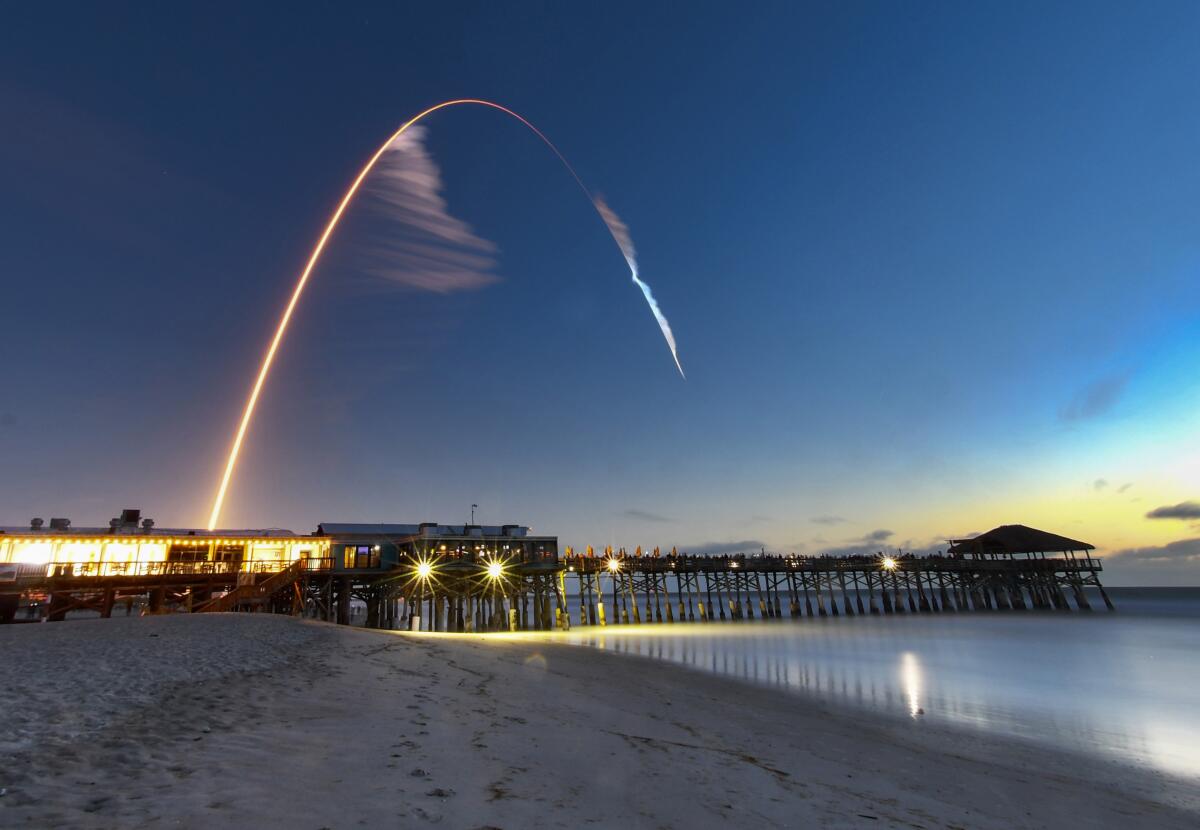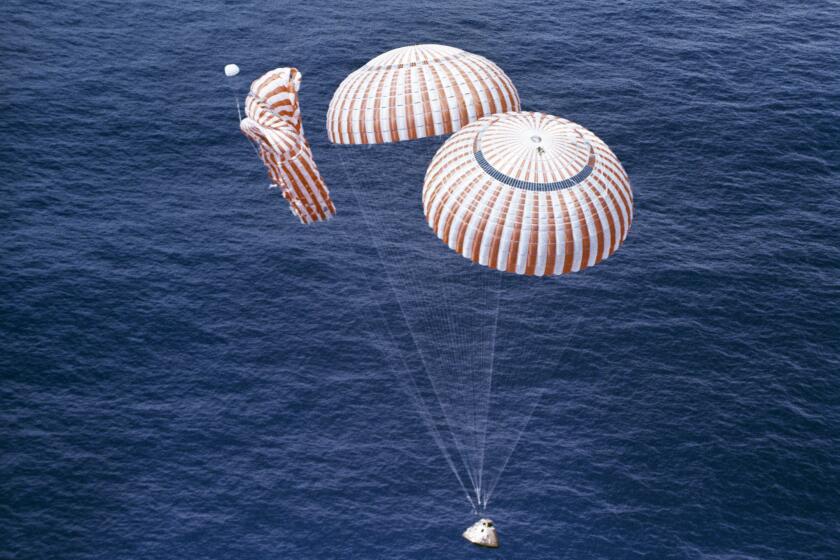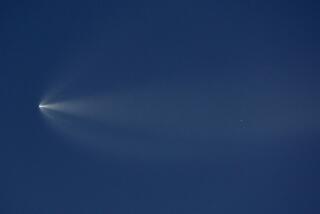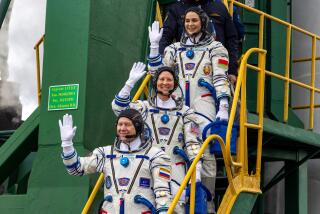Boeing’s Starliner puts itself in the wrong orbit, won’t reach space station

Boeing Co.’s new Starliner capsule launched right on time from Florida’s Cape Canaveral Air Force Station early Friday, a seemingly auspicious start for its first test flight.
The uncrewed capsule — which soon is supposed to carry astronauts — was headed to the International Space Station to prove it could dock there and then safely return to Earth.
But half an hour after liftoff, Boeing reported that the capsule didn’t get into the right orbit to reach the space station. By the time the flight control team could get a command to the spacecraft, it was too late. The Starliner capsule did not have enough fuel to get back on track.
Analysts said the mishap was unfortunate but not catastrophic. Although it could further delay Boeing’s plan to carry NASA astronauts to the space station next year, the issue did not endanger human lives or show a compromise of the capsule’s safety.
“This is not one of those things where they have to go back to the drawing board and start over again,” said Marco Cáceres, senior space analyst at market research firm Teal Group. “This is just something they have to tweak.”
A faulty timer on the spacecraft was pinpointed as a culprit: It made the spacecraft believe it was at a different part of the mission than it actually was, which threw off the capsule’s autonomous functions, NASA Administrator Jim Bridenstine told reporters Friday.
Instead of firing its thrusters to raise its orbit to get closer to the space station, the capsule was trying to maintain precise, tight control of its movement — a behavior it should have had closer to the station — which burned a lot of propellant, he said.
The flight control team’s messages to the capsule were delayed because the craft was between the reaches of two satellites and the command relay took longer. By then, the capsule had burned too much fuel.
Officials emphasized that the capsule is in a safe and stable orbit.
The Starliner capsule will remain in orbit at least until Sunday as the team continues to investigate why the timer was so off, and then will try to land at White Sands Missile Range in New Mexico, as planned, to test its parachute system, said Jim Chilton, senior vice president of Boeing’s space and launch division. That would end the eight-day mission ahead of schedule. The Starliner is carrying Christmas treats and presents that were meant for the six space station residents, as well as a sensor-laden mannequin named Rosie after the biceps-flexing riveter of World War II.
Even SpaceX and Boeing, which have accomplished great engineering feats, are still grappling with the tech.
The problem with the timer wasn’t seen in any previous tests, said Steve Stich, deputy manager of NASA’s commercial crew program.
It’s good the problem came to light now, Bridenstine said: “This is, in fact, why we test.”
He said it was too early to tell whether this setback would delay a later test flight with astronauts aboard that was expected next year. But he emphasized that had a crew been aboard this flight, they would have been safe and could have taken manual control of the vehicle, possibly getting it to the space station despite the timer malfunction.
Astronauts are used to riding in craft with fewer automated capabilities, NASA astronaut Nicole Mann told reporters. She is set to ride in the Starliner’s first crewed test flight, along with fellow NASA astronaut Mike Fincke and Chris Ferguson, a former NASA astronaut who now works for Boeing as a test pilot astronaut.
Mann said their job on the crewed test flight will be to make sure the automation works as expected.
“We train extensively for this type of contingency,” she said, referring to the mishap that occurred Friday. “Had we been on board, there could have been actions we could’ve taken.”
She said that she had no concerns about the capsule’s safety and that she looked forward to her flight.
Chicago-based Boeing and Elon Musk’s Hawthorne-based SpaceX are each working under NASA contracts to develop crew capsules to ferry NASA astronauts to and from the space station. A goal is to restore the United States’ ability to carry its astronauts to space; since the space shuttles were retired in 2011, the nation has paid Russia for that transport.
But both companies have faced delays and setbacks that pushed the first crewed flights to 2020 from 2017. In April, for example, a SpaceX Crew Dragon capsule — which had successfully flown to the space station and back — exploded during a test. Last year, a propellant leak caused a fire that damaged a Boeing test capsule. And both companies have faced issues with parachute design.
Friday’s problem comes at a tough time for Boeing, which is also battling scrutiny over its 737 Max commercial airplanes. That workhorse plane has been grounded since March after two crashes killed a total of 346 people. The Federal Aviation Administration has signaled that it would not approve the revamped Max until next year, and this week, Boeing said it would pause production of the plane. The company’s stock fell 1.6% on Friday. It’s down more than 22% since the second Max crash.
On the eve of Friday’s launch, Bridenstine said he was “very comfortable” with Boeing, despite the 737 Max situation. The spacecraft and aircraft sides of the company are different, he noted. Boeing has been involved in NASA’s human spacecraft program from the start, with a hand in Project Mercury as well as the shuttle and space station programs.
The company also has held a strong position in the satellite-building sector. It has specialized in large ones destined for a high orbit, one of which launched just Monday. Demand has been shifting toward small, lower-orbit satellites, however, and the company is trying to adjust.
On Friday, Boeing and NASA officials said they will investigate the cause of the timer mishap and make sure it is not a systemic problem with the Starliner capsule’s software.
This was a much smaller issue than, say, a problem with the propulsion or safety systems, so any number of fixes could be done quickly, said Dave Barnhart, director of the USC Space Engineering Research Center.
Investigations into problems such as explosions can take months or years, said Cáceres, the Teal Group analyst. This one will probably be shorter, he said: “It’s clearly a major system that malfunctioned, but I don’t sense that it was a massive malfunction.”
It might not even delay the project’s timeline very much.
Bridenstine said NASA might launch astronauts in the Starliner capsule without a test of its docking ability. He noted that every space shuttle mission, including early tests, had people aboard. (The shuttles were not immune to tragedy. Accidents destroyed the Challenger and the Columbia along with their crews.)
“I want to make sure we understand what the challenges were that we just had, and that we get those fixed and make sure there’s not a larger systematic problem,” Bridenstine said.
Boeing and NASA officials said other test milestones could be reached even without the capsule docking. If the company can maintain control over the spacecraft and land it successfully, the mission will yield useful data and Boeing can move forward, said Janice Starzyk, vice president of commercial space at market research and analysis firm Bryce Space and Technology.
In particular, a good landing would “show they can protect those on board, if there had been any,” she said. “Human life is always the priority.”
The Associated Press was used in compiling this report.








